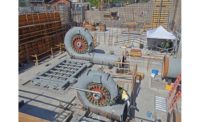Thanks to the Dept. of Energy's Loan Guarantee Program and similar incentives, solar power has become a major player in the Southwest construction market for the last half-decade or so. Most of these projects utilize photovoltaic technology.
But the Crescent Dunes Solar Energy Project in Tonopah, Nev., is a different breed. The $987-million thermal solar plant is expected to generate more than 500,000 megawatt-hours per year using advanced molten salt technology that efficiently and cost effectively stores solar energy—a world first for a utility-scale project.
"The project is based on the SolarReserve molten salt power technology that many feel is the leapfrog technology that enables for everyday storage for solar power," says Kevin Smith, CEO of SolarReserve. "This is the first utility-scale facility of this type, and we hope the Crescent Dunes project serves as the model."
After the salt is heated, it can operate at full power for at least 10 hours after the sun sets.
The project is a joint investment between SolarReserve; ACS Cobra, a Madrid-based firm specializing in engineering and construction of powerplants; and the equity capital provider Santander, a global financial services and banking firm.
SolarReserve holds the intellectual property rights regarding the molten salt process, which was initially developed by Rocketdyne in the 1990s, Smith says. ACS Cobra and Santander were recruited by SolarReserve to spur global interest in the technology.
"SolarReserve's molten salt power tower technology will change the face of solar thermal power as the world knows it, and we are excited to help implement this important technology in Nevada," said Jose Alfonso Nebrera Garcia, director general of ACS Cobra in a release announcing the financing deal in 2011.
ACS Cobra's Nevada-based affiliate, Cobra Thermosolar Plants Inc., acted as the general contractor.
"It was built largely by Southwest contractors," Smith says. "There were contractors from Arizona, Nevada, Utah and the rest of the West."
The 1,600-acre plant will align 17,500 heliostat mirrors the size of billboards in order to focus the sun's thermal energy to heat molten salt flowing through an approximately 540-ft-tall solar power tower. The heated molten salt—which will reach temperatures of about 1,500°F—will then be put in a "hot" tank to be used to boil water in a typical powerplant configuration. After the molten salt is cooled by the water during steam generation to about 500°F, it will go into a "cold" tank. The salt will then be reheated in the next solar cycle. In all, more than 60 million lb of salt will be used in the system.
Hoisting Solves Lifting Challenge
Such a one-of-a-kind project consequently brought unique construction challenges. Since the tower had a capstone, the pipes couldn't just be dropped in through the top with a crane.
"One of the biggest tasks was installing and erecting the tower's piping without a crane," says Ted Ahlin, divisional manager with Brahma Group of Salt Lake City, which built the tower's internal piping system and provided several other layers of work to the project. "Since we didn't have a crane, we had to make a system of hoists."
The tower is primarily a collection of valves and pipes utilizing 10-in.-dia carbon steel pipe and stainless steel pipe in 16-in. and 20-in. diameters, Ahlin says.
Segments of the tower—some weighing in excess of 8,000 lb—were prefabricated on the ground or at remote locations and hoisted into place with riggers stationed along the path of travel with an operator controlling the pneumatics.
To assemble the piping system through the inside of the tower, beams were installed to support the cable hoists and ship block. For outside access, scaffold supported a similar system that was disassembled and built higher after each level was built-out.








Post a comment to this article
Report Abusive Comment